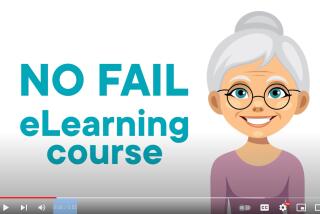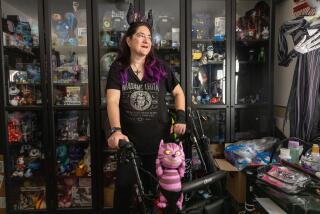Dead still alive on DMV disabled list
Martin Hochman’s aunt died in 2004, but every other year the DMV continues to mail a blue disabled placard to her last residence.
Sue Martinez’s husband also receives placards with noteworthy dependability even though he died years ago. “They just keep coming,” Martinez said.
The fraudulent use of disabled parking placards -- the blue or red badges that allow motorists to park for free or in specially reserved spaces -- is on the rise, according to the California Department of Motor Vehicles. More than a third of the placards displayed in vehicles are used illegally, officials say, costing cash-strapped municipalities millions of dollars in parking revenues.
Hochman and Martinez contend one reason is that the DMV inadvertently provides the free placards to the dead. Unable to resist temptation, relatives or friends hang the placards from their vehicles’ rear-view mirrors to avoid feeding meters or worrying about time limits.
Although Hochman and Martinez said they wouldn’t dream of misusing their deceased loved ones’ placards, many other people aren’t so noble.
Don Cocek, a Los Angeles deputy city attorney who prosecutes traffic and parking violations in Van Nuys, said people are often cited for abusing placards that belong to others. “We have a lot of people showing up with dead relatives’ placards,” he said.
With metered parking spaces now costing as much as $4 an hour, the temptation to misuse placards is growing, authorities said. In May, the DMV conducted a one-day sting operation in about 25 cities and cited more than 200 people for fraudulent use of the placards.
In an effort to clear deceased placard holders from its system, the DMV cross-checks the state’s death records against its database of placard holders, said spokesman Michael Marando. The automated system matches names with birth dates and eliminates those who have died. But this check is conducted every two years, so that the information is never fully up to date.
In this year’s cross-check, the agency pinpointed about 56,000 deceased placard holders. When the agency started sending out placards in March, it was aware of deaths only through December 2009.
There’s another problem. If the birth date on the placard application doesn’t jibe with the birth date on the death record -- as turned out to be the case with Hochman’s aunt and Martinez’s husband -- the cross-check doesn’t work, and the placard holder lives on in DMV records.
Aware of the issue but uncertain of its scale, the DMV says it is studying whether it could use private or federal databases to avoid the lag time. Officials are also considering cross-checking other details in addition to birth dates and conducting checks annually.
“We would have to look at what’s legal and what makes financial sense,” said Andrew Conway, chief of the DMV’s Registration Policy and Automation Branch.
The DMV has declined to provide its database of placard holders’ names and birth dates to the Los Angeles Times for analysis, citing state and federal laws that prohibit the release of confidential and personal information.
Under California law, cars displaying a disabled placard may park for free and are exempt from time limits at metered spaces. The placard holder does not have to own or drive a vehicle, but if a relative or friend is using the placard, the placard holder must be within “a reasonable distance.”
In March, the agency began mailing 2.1 million placards to individuals in its database. Of those, about 100,000 were returned unclaimed, typically because of a death or a bad address.
Cost is a growing issue in the program’s operation, DMV officials say. Mailing renewal placards every other year to those on the registry costs the agency about $6 million. In addition, the DMV annually generates hundreds of thousands of permanent and temporary placards for new recipients, costing another $6 million a year. Decades ago, the DMV charged a $6 fee for each placard, but in a 1990s class-action lawsuit a federal court deemed the fee illegal under the Americans With Disabilities Act.
To further complicate matters, placards are sometimes returned to the DMV in envelopes marked “deceased,” even though the person has not died.
“It’s important that the report of someone’s death comes from a reliable source,” Conway said, adding that the agency occasionally receives “requests to correct records for people who are supposedly deceased but appear in our offices saying, ‘I’m not dead. I need my placard.’ ” One explanation for the confusion, officials say, is that the placard holder has moved and the new resident mistakenly assumes the person died.
Hochman, 71, a retired lawyer in San Pedro, said he was mystified about why the DMV hadn’t caught up with his aunt’s death. After comparing documents, Hochman realized that his aunt had provided an erroneous birth date on her placard application, indicating that she was four years younger. As a result, her actual birth date and her placard-application birth date didn’t match. So the cross-check did not eliminate her from the registry.
Martinez later realized that she had inadvertently provided the wrong birth year for her husband when she applied for his placard after he suffered a stroke. The DMV was informed of his death in a timely manner, but the death record and placard record did not match. So he, too, remained in the database of permanent placard holders.
Conway acknowledged that more frequent and in-depth cross-checking of databases might end up paying for itself.
“Perhaps it will aid placard abuse enforcement enough to justify the expense,” he said.
--
More to Read
Sign up for Essential California
The most important California stories and recommendations in your inbox every morning.
You may occasionally receive promotional content from the Los Angeles Times.











